fuel pump CHEVROLET KODIAK 2007 Owners Manual
[x] Cancel search | Manufacturer: CHEVROLET, Model Year: 2007, Model line: KODIAK, Model: CHEVROLET KODIAK 2007Pages: 430, PDF Size: 6.06 MB
Page 181 of 430
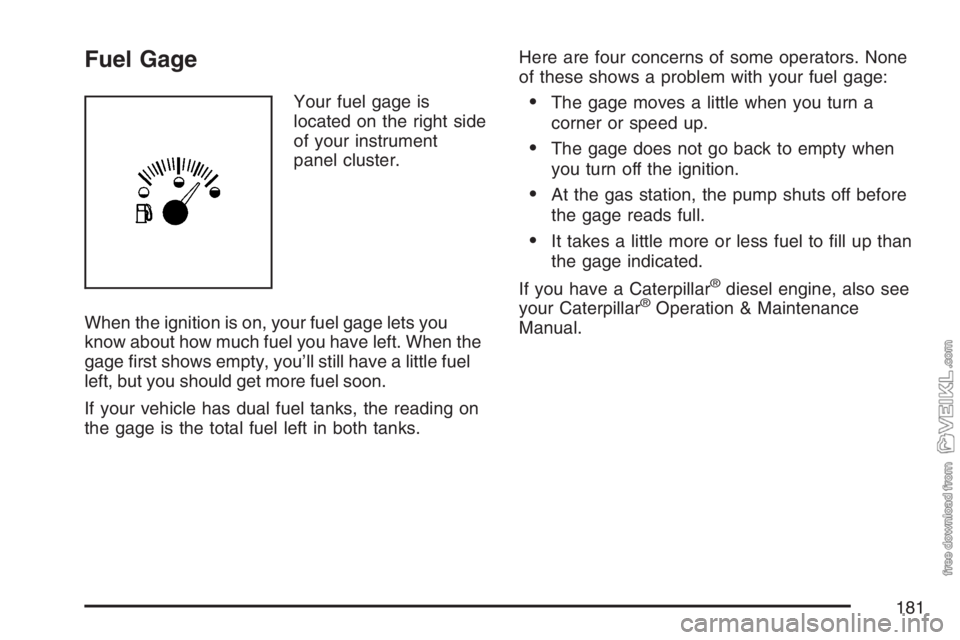
Fuel Gage
Your fuel gage is
located on the right side
of your instrument
panel cluster.
When the ignition is on, your fuel gage lets you
know about how much fuel you have left. When the
gage first shows empty, you’ll still have a little fuel
left, but you should get more fuel soon.
If your vehicle has dual fuel tanks, the reading on
the gage is the total fuel left in both tanks.Here are four concerns of some operators. None
of these shows a problem with your fuel gage:•The gage moves a little when you turn a
corner or speed up.
•The gage does not go back to empty when
you turn off the ignition.
•At the gas station, the pump shuts off before
the gage reads full.
•It takes a little more or less fuel to fill up than
the gage indicated.
If you have a Caterpillar
®diesel engine, also see
your Caterpillar®Operation & Maintenance
Manual.
181
Page 254 of 430
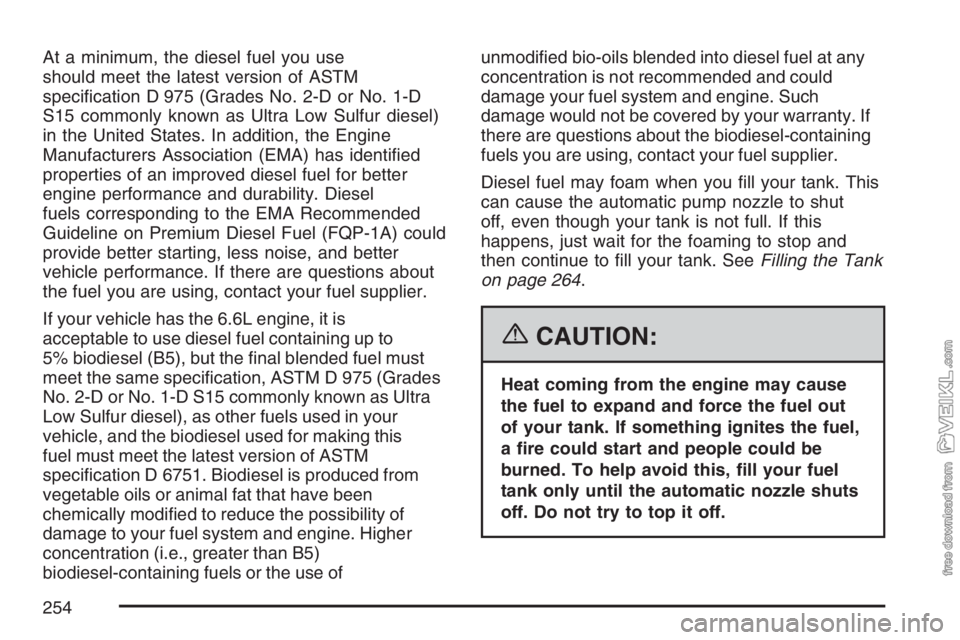
At a minimum, the diesel fuel you use
should meet the latest version of ASTM
specification D 975 (Grades No. 2-D or No. 1-D
S15 commonly known as Ultra Low Sulfur diesel)
in the United States. In addition, the Engine
Manufacturers Association (EMA) has identified
properties of an improved diesel fuel for better
engine performance and durability. Diesel
fuels corresponding to the EMA Recommended
Guideline on Premium Diesel Fuel (FQP-1A) could
provide better starting, less noise, and better
vehicle performance. If there are questions about
the fuel you are using, contact your fuel supplier.
If your vehicle has the 6.6L engine, it is
acceptable to use diesel fuel containing up to
5% biodiesel (B5), but the final blended fuel must
meet the same specification, ASTM D 975 (Grades
No. 2-D or No. 1-D S15 commonly known as Ultra
Low Sulfur diesel), as other fuels used in your
vehicle, and the biodiesel used for making this
fuel must meet the latest version of ASTM
specification D 6751. Biodiesel is produced from
vegetable oils or animal fat that have been
chemically modified to reduce the possibility of
damage to your fuel system and engine. Higher
concentration (i.e., greater than B5)
biodiesel-containing fuels or the use ofunmodified bio-oils blended into diesel fuel at any
concentration is not recommended and could
damage your fuel system and engine. Such
damage would not be covered by your warranty. If
there are questions about the biodiesel-containing
fuels you are using, contact your fuel supplier.
Diesel fuel may foam when you fill your tank. This
can cause the automatic pump nozzle to shut
off, even though your tank is not full. If this
happens, just wait for the foaming to stop and
then continue to fill your tank. SeeFilling the Tank
on page 264.
{CAUTION:
Heat coming from the engine may cause
the fuel to expand and force the fuel out
of your tank. If something ignites the fuel,
a �re could start and people could be
burned. To help avoid this, �ll your fuel
tank only until the automatic nozzle shuts
off. Do not try to top it off.
254
Page 256 of 430
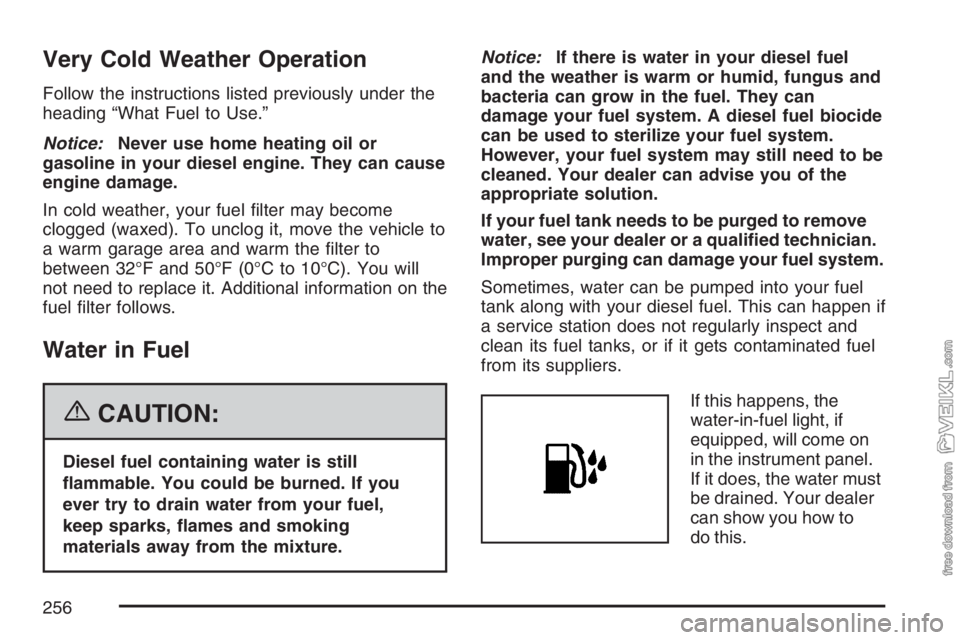
Very Cold Weather Operation
Follow the instructions listed previously under the
heading “What Fuel to Use.”
Notice:Never use home heating oil or
gasoline in your diesel engine. They can cause
engine damage.
In cold weather, your fuel filter may become
clogged (waxed). To unclog it, move the vehicle to
a warm garage area and warm the filter to
between 32°F and 50°F (0°C to 10°C). You will
not need to replace it. Additional information on the
fuel filter follows.
Water in Fuel
{CAUTION:
Diesel fuel containing water is still
�ammable. You could be burned. If you
ever try to drain water from your fuel,
keep sparks, �ames and smoking
materials away from the mixture.Notice:If there is water in your diesel fuel
and the weather is warm or humid, fungus and
bacteria can grow in the fuel. They can
damage your fuel system. A diesel fuel biocide
can be used to sterilize your fuel system.
However, your fuel system may still need to be
cleaned. Your dealer can advise you of the
appropriate solution.
If your fuel tank needs to be purged to remove
water, see your dealer or a quali�ed technician.
Improper purging can damage your fuel system.
Sometimes, water can be pumped into your fuel
tank along with your diesel fuel. This can happen if
a service station does not regularly inspect and
clean its fuel tanks, or if it gets contaminated fuel
from its suppliers.
If this happens, the
water-in-fuel light, if
equipped, will come on
in the instrument panel.
If it does, the water must
be drained. Your dealer
can show you how to
do this.
256
Page 257 of 430
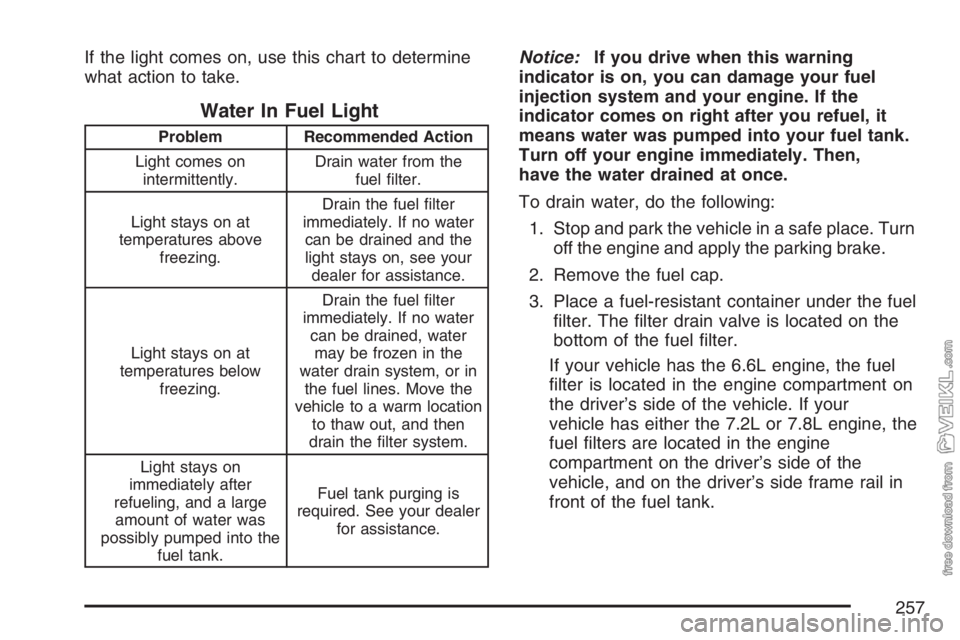
If the light comes on, use this chart to determine
what action to take.
Water In Fuel Light
Problem Recommended Action
Light comes on
intermittently.Drain water from the
fuel filter.
Light stays on at
temperatures above
freezing.Drain the fuel filter
immediately. If no water
can be drained and the
light stays on, see your
dealer for assistance.
Light stays on at
temperatures below
freezing.Drain the fuel filter
immediately. If no water
can be drained, water
may be frozen in the
water drain system, or in
the fuel lines. Move the
vehicle to a warm location
to thaw out, and then
drain the filter system.
Light stays on
immediately after
refueling, and a large
amount of water was
possibly pumped into the
fuel tank.Fuel tank purging is
required. See your dealer
for assistance.
Notice:If you drive when this warning
indicator is on, you can damage your fuel
injection system and your engine. If the
indicator comes on right after you refuel, it
means water was pumped into your fuel tank.
Turn off your engine immediately. Then,
have the water drained at once.
To drain water, do the following:
1. Stop and park the vehicle in a safe place. Turn
off the engine and apply the parking brake.
2. Remove the fuel cap.
3. Place a fuel-resistant container under the fuel
filter. The filter drain valve is located on the
bottom of the fuel filter.
If your vehicle has the 6.6L engine, the fuel
filter is located in the engine compartment on
the driver’s side of the vehicle. If your
vehicle has either the 7.2L or 7.8L engine, the
fuel filters are located in the engine
compartment on the driver’s side of the
vehicle, and on the driver’s side frame rail in
front of the fuel tank.
257
Page 258 of 430
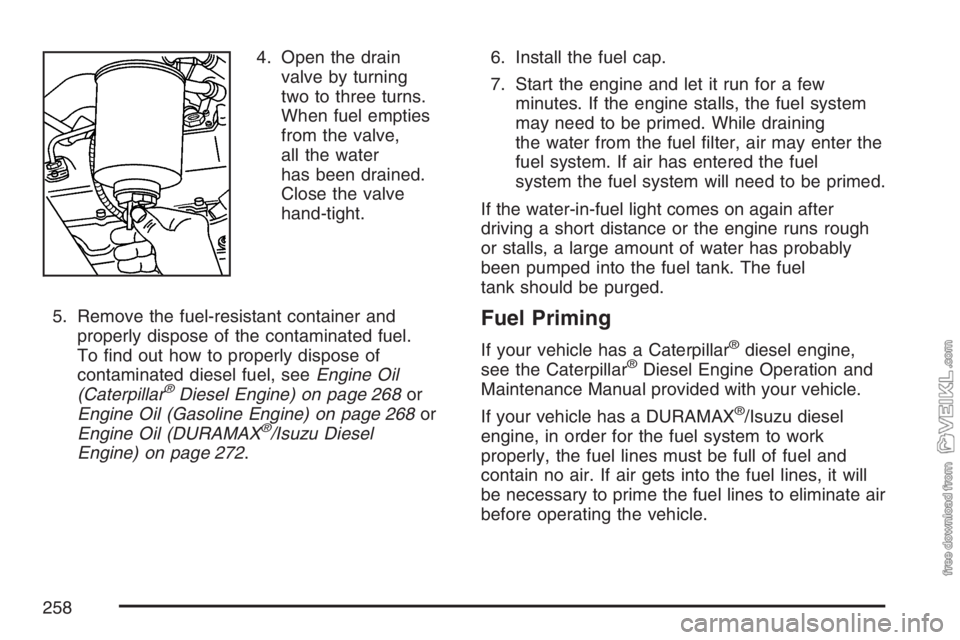
4. Open the drain
valve by turning
two to three turns.
When fuel empties
from the valve,
all the water
has been drained.
Close the valve
hand-tight.
5. Remove the fuel-resistant container and
properly dispose of the contaminated fuel.
To find out how to properly dispose of
contaminated diesel fuel, seeEngine Oil
(Caterpillar
®Diesel Engine) on page 268or
Engine Oil (Gasoline Engine) on page 268or
Engine Oil (DURAMAX
®/Isuzu Diesel
Engine) on page 272.6. Install the fuel cap.
7. Start the engine and let it run for a few
minutes. If the engine stalls, the fuel system
may need to be primed. While draining
the water from the fuel filter, air may enter the
fuel system. If air has entered the fuel
system the fuel system will need to be primed.
If the water-in-fuel light comes on again after
driving a short distance or the engine runs rough
or stalls, a large amount of water has probably
been pumped into the fuel tank. The fuel
tank should be purged.
Fuel Priming
If your vehicle has a Caterpillar®diesel engine,
see the Caterpillar®Diesel Engine Operation and
Maintenance Manual provided with your vehicle.
If your vehicle has a DURAMAX
®/Isuzu diesel
engine, in order for the fuel system to work
properly, the fuel lines must be full of fuel and
contain no air. If air gets into the fuel lines, it will
be necessary to prime the fuel lines to eliminate air
before operating the vehicle.
258
Page 259 of 430
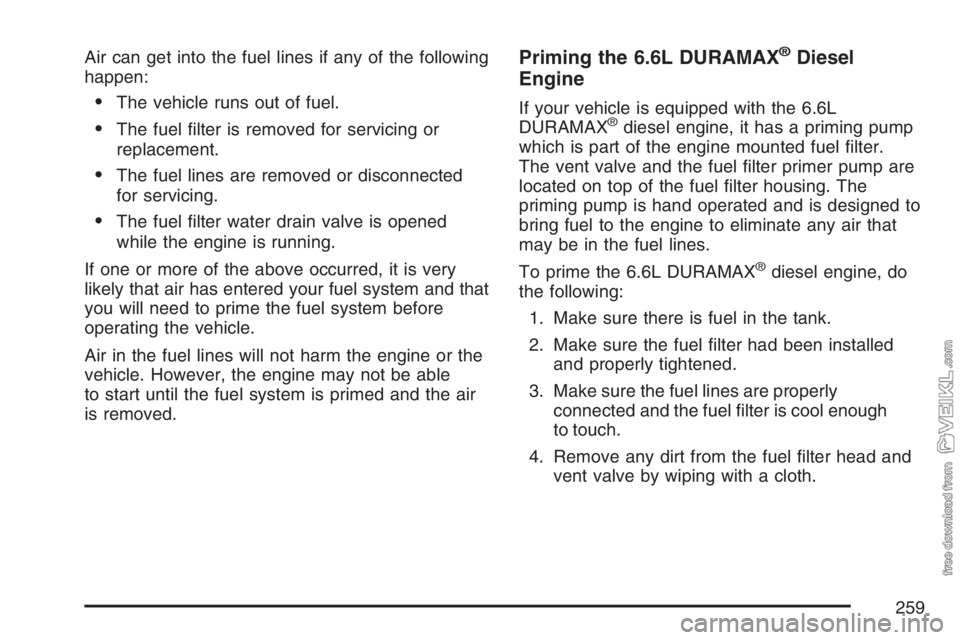
Air can get into the fuel lines if any of the following
happen:
•The vehicle runs out of fuel.
•The fuel filter is removed for servicing or
replacement.
•The fuel lines are removed or disconnected
for servicing.
•The fuel filter water drain valve is opened
while the engine is running.
If one or more of the above occurred, it is very
likely that air has entered your fuel system and that
you will need to prime the fuel system before
operating the vehicle.
Air in the fuel lines will not harm the engine or the
vehicle. However, the engine may not be able
to start until the fuel system is primed and the air
is removed.
Priming the 6.6L DURAMAX®Diesel
Engine
If your vehicle is equipped with the 6.6L
DURAMAX®diesel engine, it has a priming pump
which is part of the engine mounted fuel filter.
The vent valve and the fuel filter primer pump are
located on top of the fuel filter housing. The
priming pump is hand operated and is designed to
bring fuel to the engine to eliminate any air that
may be in the fuel lines.
To prime the 6.6L DURAMAX
®diesel engine, do
the following:
1. Make sure there is fuel in the tank.
2. Make sure the fuel filter had been installed
and properly tightened.
3. Make sure the fuel lines are properly
connected and the fuel filter is cool enough
to touch.
4. Remove any dirt from the fuel filter head and
vent valve by wiping with a cloth.
259
Page 260 of 430
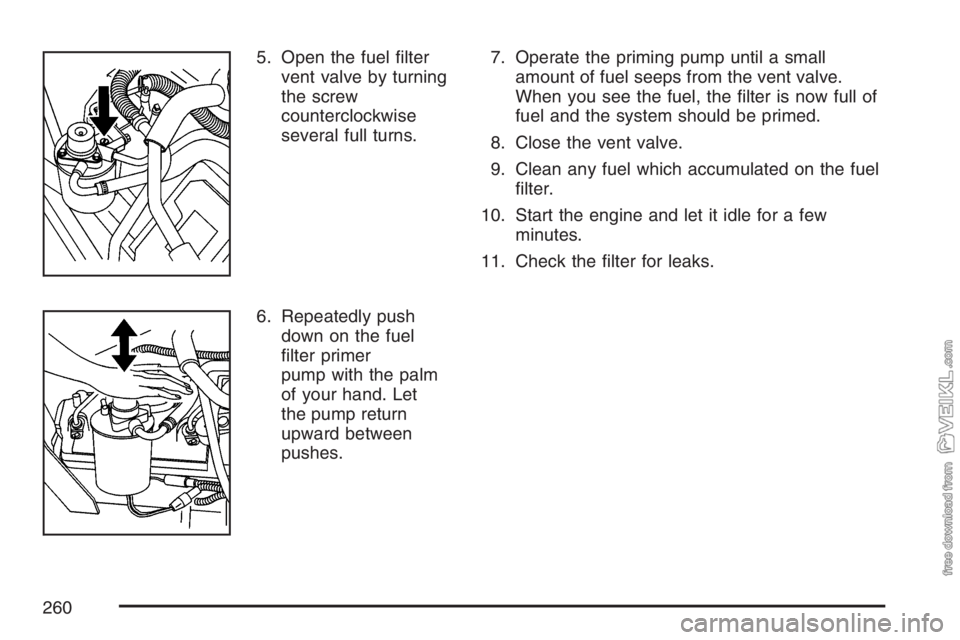
5. Open the fuel filter
vent valve by turning
the screw
counterclockwise
several full turns.
6. Repeatedly push
down on the fuel
filter primer
pump with the palm
of your hand. Let
the pump return
upward between
pushes.7. Operate the priming pump until a small
amount of fuel seeps from the vent valve.
When you see the fuel, the filter is now full of
fuel and the system should be primed.
8. Close the vent valve.
9. Clean any fuel which accumulated on the fuel
filter.
10. Start the engine and let it idle for a few
minutes.
11. Check the filter for leaks.
260
Page 261 of 430
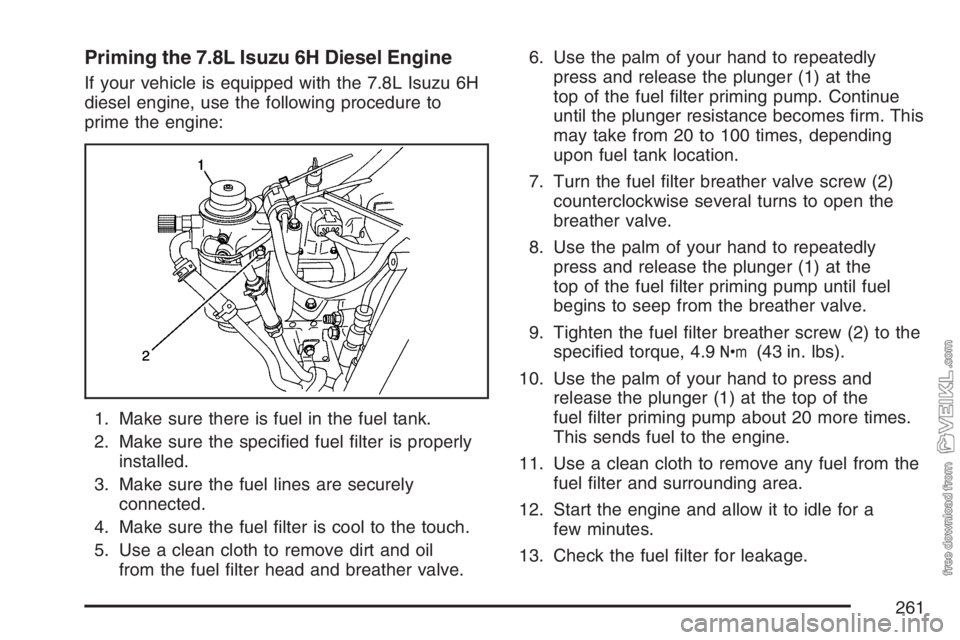
Priming the 7.8L Isuzu 6H Diesel Engine
If your vehicle is equipped with the 7.8L Isuzu 6H
diesel engine, use the following procedure to
prime the engine:
1. Make sure there is fuel in the fuel tank.
2. Make sure the specified fuel filter is properly
installed.
3. Make sure the fuel lines are securely
connected.
4. Make sure the fuel filter is cool to the touch.
5. Use a clean cloth to remove dirt and oil
from the fuel filter head and breather valve.6. Use the palm of your hand to repeatedly
press and release the plunger (1) at the
top of the fuel filter priming pump. Continue
until the plunger resistance becomes firm. This
may take from 20 to 100 times, depending
upon fuel tank location.
7. Turn the fuel filter breather valve screw (2)
counterclockwise several turns to open the
breather valve.
8. Use the palm of your hand to repeatedly
press and release the plunger (1) at the
top of the fuel filter priming pump until fuel
begins to seep from the breather valve.
9. Tighten the fuel filter breather screw (2) to the
specified torque, 4.9
Y(43 in. lbs).
10. Use the palm of your hand to press and
release the plunger (1) at the top of the
fuel filter priming pump about 20 more times.
This sends fuel to the engine.
11. Use a clean cloth to remove any fuel from the
fuel filter and surrounding area.
12. Start the engine and allow it to idle for a
few minutes.
13. Check the fuel filter for leakage.
261
Page 266 of 430
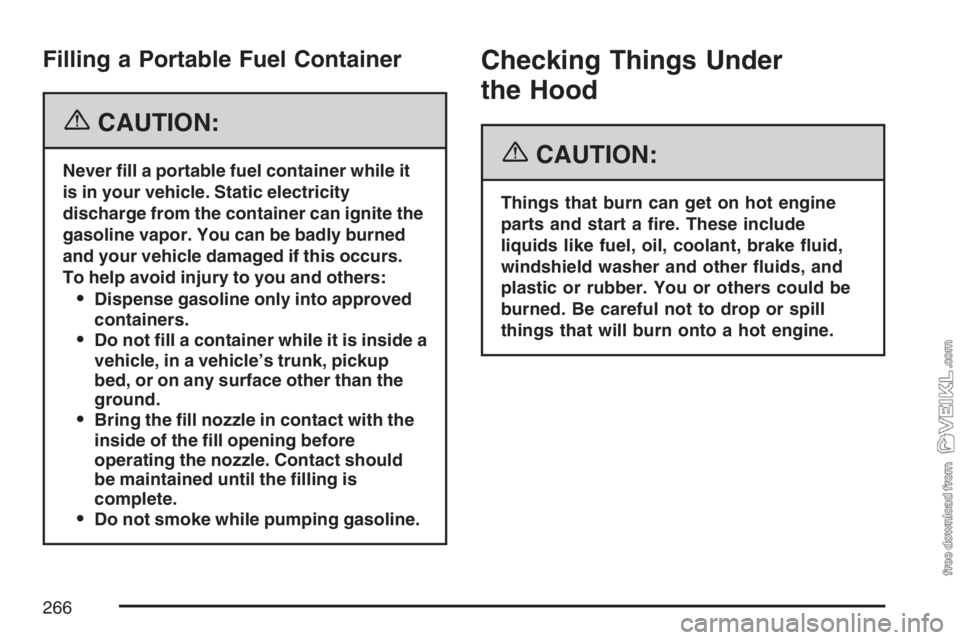
Filling a Portable Fuel Container
{CAUTION:
Never �ll a portable fuel container while it
is in your vehicle. Static electricity
discharge from the container can ignite the
gasoline vapor. You can be badly burned
and your vehicle damaged if this occurs.
To help avoid injury to you and others:
Dispense gasoline only into approved
containers.
Do not �ll a container while it is inside a
vehicle, in a vehicle’s trunk, pickup
bed, or on any surface other than the
ground.
Bring the �ll nozzle in contact with the
inside of the �ll opening before
operating the nozzle. Contact should
be maintained until the �lling is
complete.
Do not smoke while pumping gasoline.
Checking Things Under
the Hood
{CAUTION:
Things that burn can get on hot engine
parts and start a �re. These include
liquids like fuel, oil, coolant, brake �uid,
windshield washer and other �uids, and
plastic or rubber. You or others could be
burned. Be careful not to drop or spill
things that will burn onto a hot engine.
266
Page 345 of 430
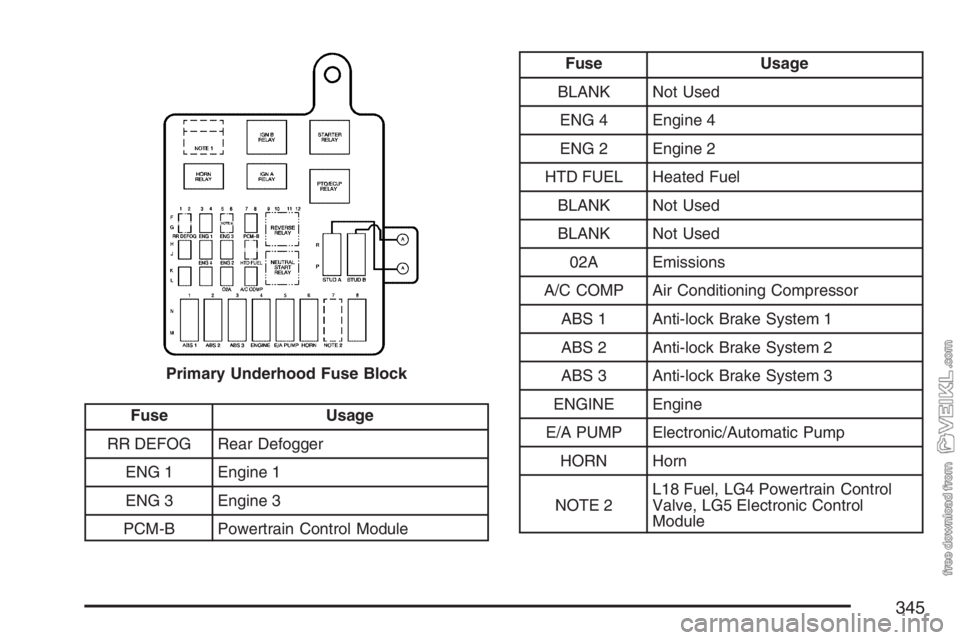
Fuse Usage
RR DEFOG Rear Defogger
ENG 1 Engine 1
ENG 3 Engine 3
PCM-B Powertrain Control Module
Fuse Usage
BLANK Not Used
ENG 4 Engine 4
ENG 2 Engine 2
HTD FUEL Heated Fuel
BLANK Not Used
BLANK Not Used
02A Emissions
A/C COMP Air Conditioning Compressor
ABS 1 Anti-lock Brake System 1
ABS 2 Anti-lock Brake System 2
ABS 3 Anti-lock Brake System 3
ENGINE Engine
E/A PUMP Electronic/Automatic Pump
HORN Horn
NOTE 2L18 Fuel, LG4 Powertrain Control
Valve, LG5 Electronic Control
Module Primary Underhood Fuse Block
345